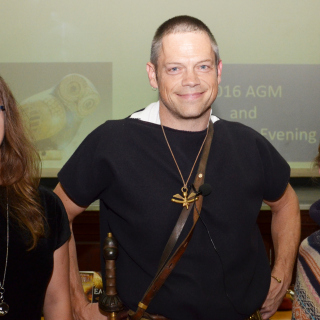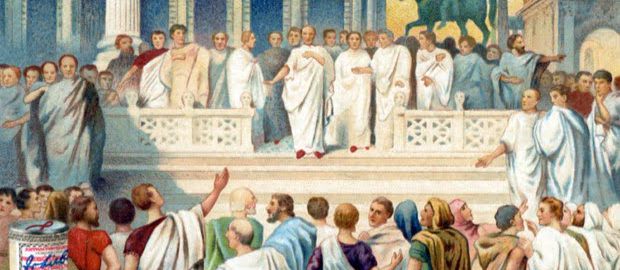Almost five years since his first appearance for the LSA CA, we were thrilled to welcome back bestselling author Ben Kane to the branch last Thursday evening for a fantastic webinar based on his latest series, Clash of Empires, as Classics Ambassador Imogen H writes:

Many of us have an interest in and awareness of the influence of Greco-Roman cultures on our legal systems and political structures, on our art, theatre, vocabulary, architecture. But the complex relationship between Greece and Rome – two imperial powers that learned, borrowed and stole from each other – is much less known and, in particular, Rome’s takeover of Greece in the second and third centuries BC is a compelling topic overlooked by many students. Moreover, as Ben discovered when researching this fascinating topic, there were very few novels already published that discussed it and he has brilliantly filled in this fictional hinterland with his own gripping storytelling.

By the third century BC, Rome had grown from a seemingly insignificant nation to a Mediterranean superpower. In 264 BC (the year the Punic Wars began), Rome was nothing compared to the powers of Macedon and Ptolemaic Egypt, but fast forward to the year 161 BC, then it was clear that Rome had become an empire to contend with. One factor that particularly aided the Romans in this aspect was the huge sense of civic duty each citizen felt towards the respublica which ensured that Rome’s legions were full of willing soldiers who found great pride in fighting for their state – the richest citizens of Rome even paid for the construction of a new fleet for its navy. In a great link to modern society, Ben pointed out how in these uncertain times, a similar sense of civic duty had compelled many of us to help each other out in so many different ways.
Travelling across the Mediterranean, Ben then discussed the state of the Macedonian empire and its ruler at this time, Philip V. Describing him as a mercurial leader, Ben identified him as both capable of great feats of daring and simultaneously extraordinary acts of stupidity. Using a large number of garrisons built across the empire (the largest of which were called the Fetters of Greece), Philip spent the majority of his time dealing with a variety of threats to his throne with a fairly high success rate. Because of his lack of popularity amongst the Greeks, Philip always had to be watchful for attacks, however he certainly did not assist himself in avoiding squabbles.

Macedon had long had eyes on the lands of Illyria, a cause of concern to Rome, and when documents containing the details of a possible alliance between Hannibal and Philip were discovered on a ship travelling between the cities, this added to Rome’s fears of conflict from the East. The final trigger for Rome declaring war on the Macedonians came from the city of Pergamon and the island of Rhodes. When Philip, who had been travelling across Asia Minor and coming into contact with territories controlled by different city states, ended up provoking the locals so badly, they boxed his fleet into a harbour for six months and requested aid from Rome. The Romans cast a vote on whether to go to war or not. Now this request was initially rejected by the Roman centuriate in the assembly, unsurprising considering they had just reached the conclusion of a twenty-year war with Carthage and sustained heavy losses throughout. However, this decision was overturned at a second assembly where the majority voted for war: an intriguing change of heart which remains unexplained despite lots of supposition. Ben’s theory, as dramatised in his books, is that the decision was likely due to a combination of bribery, skulduggery and threats but we all enjoyed reflecting on our own possible explanations.

Ben then brought us forward to the year 200 BC – the start of the war between these two civilisations. The Roman expeditionary force landed in Apollonia under an experienced Roman general who had been a consul during the wars with Hannibal. The Roman forces had two choices considering that winter was on the horizon: they could either start setting up camp and wait for spring or begin hostilities swiftly – they chose the latter. Soldiers marched up the river Apsus and came to Antipatrea where they consequently sacked the town before returning to the coast and waiting out the winter, ensuring that the army would not be stuck on the wrong side of some very precarious mountain passes.
In the spring of 199 BC, Roman troops once again marched up the river Apsus with their experienced legions and cavalry alongside an extensive number of tribesmen from Thrace and northern territories of Macedon (paradoxically, their army would eventually become more Greek than Roman!). As Ben explained, the Macedonians’ most notable tactic and their greatest strength was arguably their battle formation – the Phalanx. Hoplites were lined in rows of 16 by 16 with significantly smaller shields (only able to properly cover their forearms) but with large 20-foot spears fashioned in two parts for marching that had to be assembled for battle. The first five ranks of hoplites had lowered spears with which to attack the enemy, while the rest held theirs aloft to deflect any projectiles. Despite the efficiency of these units, Ben pointed out that they had one noticeable flaw – the flanks of these units would be utterly exposed to any enemy and therefore required surrounding soldiers to protect them.

The developed tactics and experience of soldiers of the two armies led to victories and losses on both sides and therefore a series of inconclusive campaigns during 199 BC. Once again, to avoid the perils of winter, the Romans returned to the coast where their leader was replaced twice in quick succession and they prepared for renewed conflict in the following spring. By the summer, the Macedonians and the Romans reached a stalemate whereupon, in a similar situation to the infamous betrayal at Thermopylae during the Greco-Persian wars, a herdsman was coerced into revealing the secret passages through the mountains so that the Romans could continue their attack.
Drawing the lecture to its exciting conclusion, Ben described the undoing of the Macedonian forces: using the ‘cut and burn’ tactic they deprived themselves, as well as their Roman enemy, of precious food in the winter months. Then, from a meeting of scouts developed a skirmish with more and more soldiers drawn into the fighting until it became a fully fledged battle. During this decisive battle, a Roman general noticed how a Phalanx unit had been moving away from its surrounding soldiers, leaving its unprotected flanks completely exposed to attack – which is exactly what the Romans proceeded to execute. With such a large force of men smashing into this flank, the Macedonian army was thrown into complete disarray: many turned and fled and thus the Romans began their mass slaughter of thousands; even more tragically, many died mistakenly due to a miscommunication of the Greek technique of surrendering.

And so, the great clash of two amazing empires was drawn to a close, with Rome ruling over Macedon. Philip remained in place on the throne as a puppet king, a preferable solution to the Romans rather than having to install another ruler who might become a threat. The rest of the second century BC was a tale of Roman imperial conquest including further victories in Greece with, for example, the destruction and looting of Corinth by Mummius in 146BC, but the growth of personal wealth and transformations to Rome’s architectural and economic landscape were accompanied by the rise of gang warfare and polarised politics. There are many more interesting tales still to be told and we look forward to Ben’s next books!
Once again, thank you to Ben for taking us on such a captivating journey about a fascinating topic: if you’d like to read any of his books, check out his website. We’d highly recommend all of his books, especially The Forgotten Legion, the first in his Eagles at War series, and for more on the Punic Wars, you might enjoy the Hannibal and Rome books.

You must be logged in to post a comment.